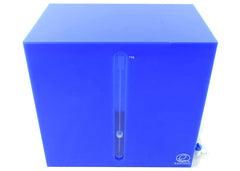How to Automate Aquarium Water Top Off Refills
Topping off your aquarium water in regards to a salt water tank, refers to the process of replacing fresh water lost to evaporation. When water evaporates from a salt water of reef aquarium, the salt stays in the tank, but the water evaporates, thus creating a need to replenish or "top off" the fresh water in the tank so that the salinity levels do not go too high, and so that heaters do not become exposed to air and so that water pumps do not run dry. Typically this is done by hauling gallons of RO/DI filtered fresh water from a reservoir to your aquarium and dumping it in. This can be heavy, and awkward, often resulting in spills and sometimes injury. We're going to explore how to automate the process of topping off your saltwater and reef aquarium with fresh RO/DI water.
 There are basically three methods that you can use to accomplish automatic top off water replacement, pressure feed, gravity feed and pump feed. For the pressure feed method, you install an automatic float switch (such as this one from eShopps) on your sump, and run some water tubing line directly from your RO/DI filter to your sump. As the water level falls due to water evaporation, the float valve opens up and allows RO/DI water to trickle in due to the back pressure created on the RO/DI filter system. Once the water level reaches it's maximum, the float valve automatically closes.
There are basically three methods that you can use to accomplish automatic top off water replacement, pressure feed, gravity feed and pump feed. For the pressure feed method, you install an automatic float switch (such as this one from eShopps) on your sump, and run some water tubing line directly from your RO/DI filter to your sump. As the water level falls due to water evaporation, the float valve opens up and allows RO/DI water to trickle in due to the back pressure created on the RO/DI filter system. Once the water level reaches it's maximum, the float valve automatically closes.
 The gravity feed method is similar in that you use an automatic shut off float valve on an incoming water feed, however in this case you would set up a separate RO/DI freshwater reservoir that feeds water into the sump. The reservoir must be position at a level that is higher than the tube entering the sump, so that the water can be trickled into the sump by gravity when the float valve opens up.
The gravity feed method is similar in that you use an automatic shut off float valve on an incoming water feed, however in this case you would set up a separate RO/DI freshwater reservoir that feeds water into the sump. The reservoir must be position at a level that is higher than the tube entering the sump, so that the water can be trickled into the sump by gravity when the float valve opens up.
 The third method to automate your water top off is the pump feed method. This method employs a water pump, and a controller device using 2 float valves and a solenoid or microchip controller. One float valve is placed in the sump to the desired maximum water level, and the other is set to the desired minimum water level. Both electronic float valves connect to the control unit which has a solenoid or microchip controller in it. When the water level gets too low, the control unit turns on an electronic water pump that is in a RO/DI freshwater reservoir. The water pump is plumbed to the sump with pvc pipe, tubing or a hose, and it pushes the fresh water into the sump until it reaches the desired water level. At this point the high level float valve sends a signal to the controller which shuts off the electric pump.
The third method to automate your water top off is the pump feed method. This method employs a water pump, and a controller device using 2 float valves and a solenoid or microchip controller. One float valve is placed in the sump to the desired maximum water level, and the other is set to the desired minimum water level. Both electronic float valves connect to the control unit which has a solenoid or microchip controller in it. When the water level gets too low, the control unit turns on an electronic water pump that is in a RO/DI freshwater reservoir. The water pump is plumbed to the sump with pvc pipe, tubing or a hose, and it pushes the fresh water into the sump until it reaches the desired water level. At this point the high level float valve sends a signal to the controller which shuts off the electric pump.
The gravity feed and pump feed methods require that you set up an RO/DI fresh water reservoir, and all three methods require the use of a sump or refugium. Automating the top off water replacement in your reef tank or saltwater aquarium is easy to do and is a great idea. It saves you the hassle of dumping heavy buckets of fresh RO/DI water into your aquarium, and it helps keep your salinity levels stable because the fresh water is replaced a little at a time, as needed. This is beneficial to your corals, your fish, your equipment and you!

